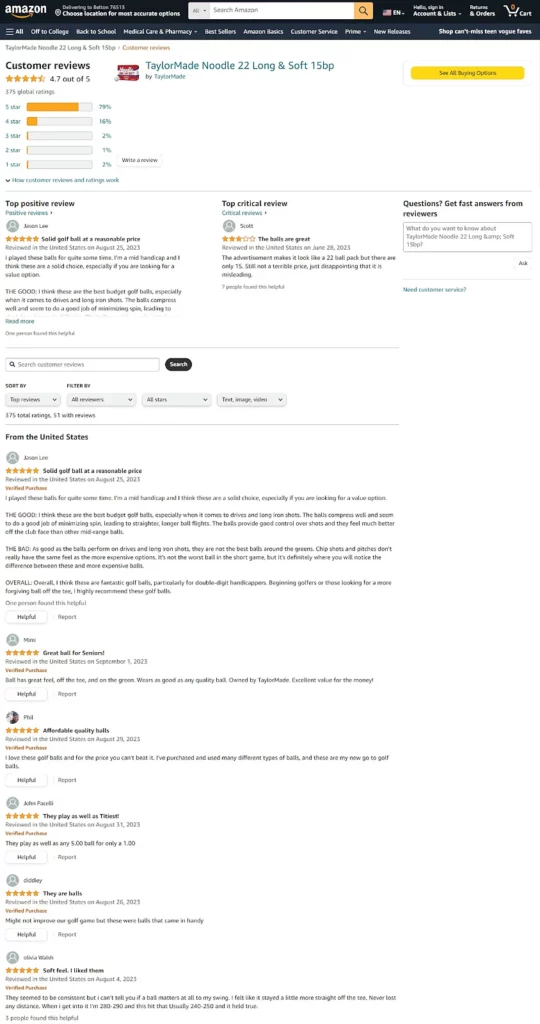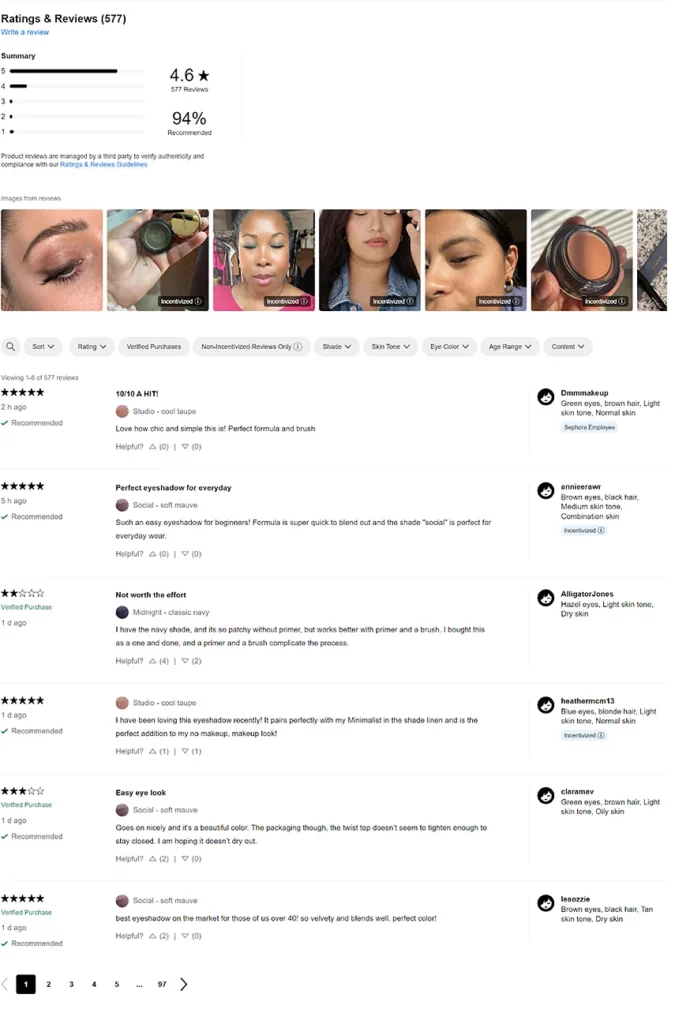User-Generated Content, commonly abbreviated as UGC, is the digital lifeblood of modern ecommerce.
UGC refers to any content that is created and shared by users or customers rather than the brand itself. This type of content can take various forms, including product reviews, ratings, customer photos and videos, social media posts, and more.
It is the digital word-of-mouth, where customers share their experiences, opinions, and insights about products or services they have used.
It’s the product review that guides your purchasing decision, the unboxing video that showcases a product in action, or the Instagram post featuring someone enjoying a new purchase.
Below is an example of a user-generated content where an Instagram user shared a brief makeup tutorial video and tagged the product brands that she used, in the captions.

Source: Instagram | brittanyogus
The role of UGC in ecommerce marketing cannot be overstated. That’s because consumers trust the opinions and experiences of their peers far more than traditional marketing messages.
The Power of UGC in Building Trust
UGC serves as a genuine, unbiased source of information, offering a window into what it’s truly like to engage with a product or service.
It’s not just about reading product reviews; it’s about witnessing real people showcasing products in their everyday lives through images, videos, and stories.
UGC has the power to establish trust, foster authenticity, and significantly influence purchasing decisions.
Why Consumers Trust UGC
User-Generated Content has become a cornerstone of trust. Consumers rely on UGC for various reasons, from validating the quality and utility of a product to seeking inspiration for their own purchases.
1. Authenticity
UGC is often perceived as more authentic and genuine compared to branded content. It’s created by real people who have no vested interest in promoting a product, making it inherently trustworthy.
2. Peer Recommendations
People tend to trust recommendations from their peers or individuals with similar lifestyles and preferences. UGC allows consumers to relate to those who have already used the product, creating a sense of trust.
3. Transparency
UGC provides transparency into the actual experiences of other consumers. It offers an unfiltered view of the product’s strengths and weaknesses, helping potential buyers make informed decisions.
4. Social Proof
When consumers see that others have had positive experiences with a product, it acts as social proof. It reassures them that they are making a wise choice by purchasing the same product.
5. Emotional Connection
UGC often includes personal stories, photos, or videos, which can evoke emotions and create a deeper connection with potential customers. This emotional resonance builds trust and brand loyalty.
Statistics on the impact of UGC on Consumer Behavior
The impact of UGC on consumer behavior is not anecdotal; it’s backed by solid statistics:
1. Conversion Rates
Studies have shown that ecommerce websites featuring UGC experience up to a 3.2% increase in conversion rates whereas UGC interactions led to a 102.4% increase in conversion. When potential buyers see positive UGC, they are more likely to complete a purchase.

2. Purchase Decisions
Approximately 80% of consumers say that UGC influences their purchase decisions. Whether it’s product reviews, user-generated images, or social media endorsements, UGC plays a pivotal role in shaping what consumers buy.
3. Trustworthiness
According to a survey by Nielsen, 92% of consumers trust recommendations from friends and family. Whereas, 68% of consumers say they deal with businesses because of positive reviews.

4. Engagement
UGC generates higher levels of engagement on social media platforms. Posts that incorporate UGC receive 28% higher engagement rates than those without it. This increased engagement can lead to brand loyalty.
5. Brand Authenticity
Brands that incorporate UGC into their marketing strategies are seen as more authentic. A staggering 86% of consumers believe authenticity is a key factor when deciding which brands to support.
Examples of Successful UGC-driven Trust-building Strategies Deployed in Ecommerce Marketing
Successful UGC-driven trust-building strategies deployed in ecommerce marketing are numerous, and they span various industries and platforms. Here are some notable examples:
1. Amazon’s Customer Reviews
Amazon is a prime example of a platform that leverages customer reviews to build trust. Their review system allows shoppers to read and leave detailed feedback on products, helping potential buyers make informed choices. Amazon’s success is partially attributed to the trust engendered by these reviews.

Source: Amazon
2. ASOS: #AsSeenOnMe Campaign
ASOS, a popular online fashion retailer, ran a successful campaign that encouraged customers to share their style by using the hashtag #AsSeenOnMe on social media.
They aggregated these user-generated photos on their website, allowing shoppers to see how real people are wearing their products.
This strategy not only showcases their clothing in real-world contexts but also builds a sense of community and trust among their customer base.

3. Sephora: User-Generated Reviews and Ratings
Sephora, a cosmetics and beauty retailer, allows customers to leave detailed product reviews and ratings on their website.
Shoppers can filter reviews by skin type, age, and other factors, helping them find products that suit their specific needs.
The extensive UGC in the form of reviews and ratings serves as a trusted resource for beauty enthusiasts, contributing to their decision-making process.

Source: Sephora
How to Incorporate UGC in Ecommerce Marketing
User-Generated Content (UGC) can be a powerful tool for ecommerce brands to drive sales and enhance their marketing efforts. Here’s how UGC can help ecommerce brands boost sales and how to effectively incorporate it into ecommerce marketing strategies:
1. Use of UGC in Building Trust and Credibility for Pre-purchase Decision-making
- Leverage Customer Reviews: Encourage customers to leave reviews and ratings for products they’ve purchased. Positive reviews and high ratings build trust and credibility, reassuring potential buyers about the quality of your products.
- Display Real-Life Experiences: Showcase UGC such as user-generated images and videos that feature customers using your products. This allows shoppers to see the products in action and helps them trust that your offerings will meet their needs.
2. Enhancing Product Discovery
- Curate User-Generated Recommendations: Encourage customers to share their favorite products and recommendations on social media using branded hashtags. Curate and display these recommendations on your website to help shoppers discover new products.
- Implement a “Customers Also Bought” Section: Showcase UGC-driven recommendations on product pages, suggesting complementary or related products based on what others have purchased.
3. Increasing Engagement
- Run UGC Contests and Challenges: Organize contests or challenges that encourage customers to create and share UGC related to your products. This not only boosts engagement but also generates fresh content for your marketing.
- User-Generated Content Campaigns: Develop specific UGC campaigns that encourage customers to participate in challenges, share their stories, or create content related to your brand. Offer incentives such as discounts or exclusive access to encourage participation.
4. Expanding Social Proof
- Create a hashtag for UGC: This will help you collect and track all of your UGC videos in one place. You can then share these videos on your social media channels and website.
- Feature UGC on Social Media: Share user-generated content on your social media channels to amplify the social proof of your products. This can lead to increased visibility and engagement on social platforms.
5. Build UGC-driven Email Marketing Campaigns
- Incorporate UGC into your email marketing campaigns. Include snippets of customer reviews or feature user-generated images in your product recommendation emails.
Use UGC to personalize email content and make product suggestions based on a customer’s browsing and purchase history.
6. Encourage User Loyalty and Advocacy
- Reward Loyal Customers: Recognize and reward customers who frequently engage in creating UGC or referring others. This can foster a sense of belonging and loyalty.
- Highlight Customer Stories: Share success stories of long-time customers who have benefited from your products or services. This not only showcases user satisfaction but also encourages advocacy.
7. Utilize Influencer Collaborations
Sign up your most loyal customers as brand advocates and partner with influencers who align with your brand and encourage them to create UGC featuring your products. When you bring influencers to market products, you get a chance to tap into their followers and amplify reach.
Example of a successful influencer marketing campaigns using UGC:
Daniel Wellington’s Influencer Campaign: Daniel Wellington, a watch brand, collaborated with micro-influencers who posted UGC featuring their watches. The campaign resulted in a massive increase in brand awareness and sales.
8. Incorporate Video Marketing
Incorporating video marketing into User-Generated Content (UGC) can be a powerful strategy to drive ecommerce sales. Video content is highly engaging and can provide potential customers with an immersive and informative experience.
- Collaborate with influencers and customers to create video reviews, tutorials, or testimonials featuring your products.
- Host live video shopping events on platforms like TikTok, Amazon, YouTube. Showcase your products in real-time and interact with viewers by answering questions and providing product details.
- Encourage viewers to make purchases during the live stream by offering limited-time discounts or promotions.
9. Monitoring and Moderation
Implement moderation practices to ensure the quality and appropriateness of user-generated content. This helps maintain a positive brand image and prevents the spread of harmful content.
10. Measure the Impact
- Use Analytics: Implement analytics tools to measure the impact of UGC on your ecommerce sales and marketing efforts. Track key performance indicators (KPIs) such as conversion rates, engagement metrics, and revenue generated from UGC campaigns.
User-generated content is a powerful tool that can be used to drive ecommerce sales. By turning shoppers into storytellers, businesses can create authentic and engaging content that will help them connect with potential customers.
Imagine an ecommerce experience that goes beyond the ordinary, where the stories of shoppers come to life through live shopping events, shoppable videos, and a host of other ecommerce capabilities. Vimmi’s platform offers precisely that – a dynamic ecosystem where UGC is seamlessly integrated with the latest technologies to create an immersive shopping experience.
With Vimmi, you can:
- Embrace Live Shopping: Engage with your audience in real-time, answer their questions, and showcase your products through live video streams. Create an interactive shopping environment that brings your brand closer to your customers.
- Transform Videos into Storefronts: Convert your videos into shoppable experiences. Allow viewers to click on products they see in videos and make instant purchases, making the shopping journey more intuitive and exciting.
- Amplify User-Generated Content: Harness the power of UGC on Vimmi’s platform to showcase authentic customer stories, reviews, and experiences. Let your customers become your brand ambassadors and storytellers.
- Measure Success: Vimmi provides robust analytics tools to track the impact of your UGC-driven campaigns, helping you understand what resonates with your audience and optimizing your strategies accordingly.
As we navigate the future of ecommerce marketing, Vimmi’s platform opens up new horizons for brands and shoppers alike. It’s a place where UGC takes center stage, and every shopper has the potential to become a storyteller, shaping the narrative of your brand.
